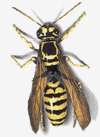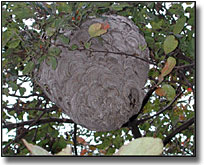
 Throughout the summer months, it is not uncommon for humans to have close encounters of the stinging kind as they use lawn mowers, edging tools or any other lawn equipment that makes noise. The sounds made by various lawn tools will anger and disturb yellow jackets in the immediate area. These stinging pests (often misidentified as ground hornets or honey bees) will often take a bulldozer "hostage," as the equipment operator abandons the equipment for safer ground.
Throughout the summer months, it is not uncommon for humans to have close encounters of the stinging kind as they use lawn mowers, edging tools or any other lawn equipment that makes noise. The sounds made by various lawn tools will anger and disturb yellow jackets in the immediate area. These stinging pests (often misidentified as ground hornets or honey bees) will often take a bulldozer "hostage," as the equipment operator abandons the equipment for safer ground.
Yellowjackets are Vespids (Family Vespidae), a group of some of the more dangerous of the stinging insect pests. Yellowjackets are among the smallest of this group of stinging insects. These pests are social, building nests that can be quite large. Nests are made from a material called carton or paper. This material is produced by females who combine their saliva excretions with wood fibers to form the familiar looking paper nest. A paper nest can be built by hornets, paper wasps and yellowjackets, but the yellowjackets nest is usually not visible. This nest is usually underground but there are many cases where these insects have built nests above ground in the wall voids of homes.
A home in Valdosta, GA was seen with a huge nest built on the exterior wall of the structure, with a nest so large (about 12 feet long, along the side of the wall) it was easily seen from the road. Underground nests and hidden wall nests are eliminated with the same procedures and pest control products mentioned in the Yellow jacket Elimination section of this article.
 A yellow jacket nest resembles a hornet nest and can be inhabited by thousands of workers. In most areas of the country, the majority of the pest population does not survive the cold winter months. In parts of Florida and California it is not uncommon to find perennial nests that live throughout the entire year. This situation creates even larger colonies in the nests, which is a great hazard to the unsuspecting person or family dog that ventures too close to the nest or nest entrance.
A yellow jacket nest resembles a hornet nest and can be inhabited by thousands of workers. In most areas of the country, the majority of the pest population does not survive the cold winter months. In parts of Florida and California it is not uncommon to find perennial nests that live throughout the entire year. This situation creates even larger colonies in the nests, which is a great hazard to the unsuspecting person or family dog that ventures too close to the nest or nest entrance.
The German Yellow jacket is another stinging insect that is often found in attics, crawl spaces, inside hollow blocks or other voids of homes in the northeast United States. German Yellowjackets found in other areas of the United States usually nest beneath the soil, in ground burrows or nests.
Yellowjackets will feed on a variety of items that contain sugars, proteins and carbohydrates. Some of the foods this pests are seen eating: beer, aphids, caterpillars, flies, meat (usually from the carcass of a dead animal or fish,) and various items found in garbage cans. Left-over citrus drinks and residue from beverage cans are the main reason why schools have problems with children being attacked or stung while on campus.
Without regular emptying and cleaning of all trash receptacles, schools can expect yellowjackets or wasps to have regular attendance on their property. While school personnel should be told about the severity of the problem and instructed to constantly monitor and clean such receptacles, students should also be involved. Their participation in keeping trash in trash bins (instead of close to trash bins!) will go a long way in the sanitation, prevention of stinging pests.
 The Bald Faced Hornet's nest can be as small as a football and as large as 3-4 feet long. Do not attempt to contact or handle a nest. Hornets will vigorously defend their nest if you come in contact with it or are perceived as a threat. Not all nests are found hanging from tree branches. Sometimes, nests can be found attached to the underside of external stair units, onto the sides of buildings and under porches.
The Bald Faced Hornet's nest can be as small as a football and as large as 3-4 feet long. Do not attempt to contact or handle a nest. Hornets will vigorously defend their nest if you come in contact with it or are perceived as a threat. Not all nests are found hanging from tree branches. Sometimes, nests can be found attached to the underside of external stair units, onto the sides of buildings and under porches.
WARNING --- DO NOT ATTEMPT TO CONTACT, HANDLE OR EXTERMINATE THESE INSECTS AND THEIR NEST YOURSELF - A MASS STINGING EPISODE CAN BE VERY HARMFUL OR FATAL!
